CYCS Monoclonal Antibody(4B10)
- Catalog No.:YM3402
- Applications:WB;IF;IHC
- Reactivity:Human;Mouse;Rat;Chicken
- Target:
- Cytochrome C
- Fields:
- >>Oxidative phosphorylation;>>Metabolic pathways;>>Platinum drug resistance;>>p53 signaling pathway;>>Apoptosis;>>Apoptosis - multiple species;>>Non-alcoholic fatty liver disease;>>Alzheimer disease;>>Parkinson disease;>>Amyotrophic lateral sclerosis;>>Huntington disease;>>Spinocerebellar ataxia;>>Prion disease;>>Pathways of neurodegeneration - multiple diseases;>>Pathogenic Escherichia coli infection;>>Shigellosis;>>Salmonella infection;>>Legionellosis;>>Toxoplasmosis;>>Tuberculosis;>>Hepatitis C;>>Hepatitis B;>>Measles;>>Human cytomegalovirus infection;>>Influenza A;>>Kaposi sarcoma-associated herpesvirus infection;>>Herpes simplex virus 1 infection;>>Epstein-Barr virus infection;>>Human immunodeficiency virus 1 infection;>>Pathways in cancer;>>Colorectal cancer;>>Small cell lung cancer;>>Viral myocarditis;>>Lipid and atherosclerosis
- Gene Name:
- CYCS
- Protein Name:
- Cytochrome c
- Human Gene Id:
- 54205
- Human Swiss Prot No:
- P99999
- Mouse Swiss Prot No:
- P62897
- Rat Swiss Prot No:
- P62898
- Immunogen:
- Recombinant Protein of CYCS
- Specificity:
- The antibody detects endogenous CYCS protein.
- Formulation:
- PBS, pH 7.4, containing 0.5%BSA, 0.02% sodium azide as Preservative and 50% Glycerol.
- Source:
- Monoclonal, Mouse
- Dilution:
- WB 1:1000-5000 IHC 1:500-1000 IF 1:200
- Purification:
- The antibody was affinity-purified from mouse ascites by affinity-chromatography using epitope-specific immunogen.
- Storage Stability:
- -15°C to -25°C/1 year(Do not lower than -25°C)
- Other Name:
- CYCS;CYC;Cytochrome c
- Observed Band(KD):
- 14kD
- Background:
- This gene encodes a small heme protein that functions as a central component of the electron transport chain in mitochondria. The encoded protein associates with the inner membrane of the mitochondrion where it accepts electrons from cytochrome b and transfers them to the cytochrome oxidase complex. This protein is also involved in initiation of apoptosis. Mutations in this gene are associated with autosomal dominant nonsyndromic thrombocytopenia. Numerous processed pseudogenes of this gene are found throughout the human genome.[provided by RefSeq, Jul 2010],
- Function:
- disease:Defects in CYCS are the cause of thrombocytopenia type 4 (THC4) [MIM:612004]; also known as autosomal dominant thrombocytopenia type 4. Thrombocytopenia is the presence of relatively few platelets in blood. THC4 is a non-syndromic form of thrombocytopenia. Clinical manifestations of thrombocytopenia are absent or mild. THC4 may be caused by dysregulated platelet formation.,function:Electron carrier protein. The oxidized form of the cytochrome c heme group can accept an electron from the heme group of the cytochrome c1 subunit of cytochrome reductase. Cytochrome c then transfers this electron to the cytochrome oxidase complex, the final protein carrier in the mitochondrial electron-transport chain.,function:Plays a role in apoptosis. Suppression of the anti-apoptotic members or activation of the pro-apoptotic members of the Bcl-2 family leads to altered mitochondrial membrane perm
- Subcellular Location:
- Mitochondrion intermembrane space. Loosely associated with the inner membrane.
- Expression:
- Amygdala,Bone marrow,Brain,Embryo,Heart,Kidney,Lung,Skeletal muscle,Skin,Testis,Uri
Lianhuaqingwen alleviates p53-mediated apoptosis in alveolar epithelial cells to prevent LPS-induced ALI IF Human 1:100 /A549 cell
The role of Se content in improving anti-tumor activities and its potential mechanism for selenized Artemisia sphaerocephala polysaccharides. Food & Function Food Funct. 2021 Mar;12(5):2058-2074 WB Human HepG2 cell
Mechanisms Underlying the Effects of Lianhua Qingwen on Sepsis-Induced Acute Lung Injury: A Network Pharmacology Approach. Frontiers in Pharmacology Front Pharmacol. 2021 Oct;0:2839 WB Mouse Lung
Target Identification-Based Analysis of Mechanism of Betulinic Acid-Induced Cells Apoptosis of Cervical Cancer SiHa: Natural Product Communications Hao Sun WB Human
Preliminary Structural Characterization of Selenium Nanoparticle Composites Modified by Astragalus Polysaccharide and the Cytotoxicity Mechanism on Liver Cancer Cells MOLECULES Xiaoyu Jia WB Human HepG2 cell
Indisulam exerts anticancer effects via modulation of transcription, translation and alternative splicing on human cervical cancer cells. Cuixia Di WB Human 1:1000 HeLa cell
Investigation of the Mechanisms and Experimental Verification of Yulin Formula in the Treatment of Diminished Ovarian Reserve via Network Pharmacology. Qin Zhang WB Rat ovarian tissues
Bruceine A: Suppressing metastasis via MEK/ERK pathway and invoking mitochondrial apoptosis in triple-negative breast cancer. BIOMEDICINE & PHARMACOTHERAPY Jun Lu WB Mouse,Human 1:1000 MDA-MB-231 cell,4T1 cell
Novel sulfonyl-substituted tetrandrine derivatives for colon cancer treatment by inducing mitochondrial apoptosis and inhibiting PI3K/AKT/mTOR pathway BIOORGANIC CHEMISTRY Jie Ling WB Human,Mouse HCT116 cell,CT26 cell
Neuroprotective effects of total phenolics from Hemerocallis citrina Baroni leaves through the PI3K/AKT pathway Frontiers in Pharmacology Jia Yanjun WB Rat PC12 cell
- June 19-2018
- WESTERN IMMUNOBLOTTING PROTOCOL
- June 19-2018
- IMMUNOHISTOCHEMISTRY-PARAFFIN PROTOCOL
- June 19-2018
- IMMUNOFLUORESCENCE PROTOCOL
- September 08-2020
- FLOW-CYTOMEYRT-PROTOCOL
- May 20-2022
- Cell-Based ELISA│解您多样本WB检测之困扰
- July 13-2018
- CELL-BASED-ELISA-PROTOCOL-FOR-ACETYL-PROTEIN
- July 13-2018
- CELL-BASED-ELISA-PROTOCOL-FOR-PHOSPHO-PROTEIN
- July 13-2018
- Antibody-FAQs
- Products Images

- Immunofluorescence analysis of Hela cell. 1,c-Myc Polyclonal Antibody(red) was diluted at 1:200(4° overnight). CYCS Monoclonal Antibody(4B10)(green) was diluted at 1:200(4° overnight). 2, Goat Anti Rabbit Alexa Fluor 594 Catalog:RS3611 was diluted at 1:1000(room temperature, 50min). Goat Anti Mouse Alexa Fluor 488 Catalog:RS3208 was diluted at 1:1000(room temperature, 50min).

- Western blot analysis of lysates from 1) Hela, 2) 293T, 3) 3T3, cells, (Green) primary antibody was diluted at 1:1000, 4°over night, secondary antibody(cat:RS23910)was diluted at 1:10000, 37° 1hour. (Red) GAPDH Polyclonal Antibody (cat:YM3215) antibody was diluted at 1:5000 as loading control, 4° over night,secondary antibody(cat:RS23720)was diluted at 1:10000, 37° 1hour.

- Immunohistochemical analysis of paraffin-embedded Human-Tonsil tissue. 1,CYCS Monoclonal Antibody(4B10) was diluted at 1:200(4°C,overnight). 2, Sodium citrate pH 6.0 was used for antibody retrieval(>98°C,20min). 3,Secondary antibody was diluted at 1:200(room tempeRature, 30min). Negative control was used by secondary antibody only.
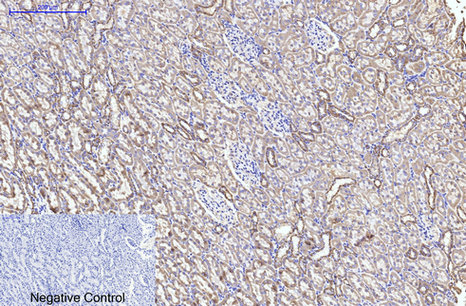
- Immunohistochemical analysis of paraffin-embedded Rat-kidney tissue. 1,CYCS Monoclonal Antibody(4B10) was diluted at 1:200(4°C,overnight). 2, Sodium citrate pH 6.0 was used for antibody retrieval(>98°C,20min). 3,Secondary antibody was diluted at 1:200(room tempeRature, 30min). Negative control was used by secondary antibody only.
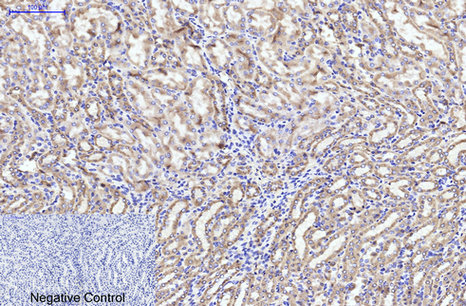
- Immunohistochemical analysis of paraffin-embedded Mouse-kidney tissue. 1,CYCS Monoclonal Antibody(4B10) was diluted at 1:200(4°C,overnight). 2, Sodium citrate pH 6.0 was used for antibody retrieval(>98°C,20min). 3,Secondary antibody was diluted at 1:200(room tempeRature, 30min). Negative control was used by secondary antibody only.

- Immunofluorescence analysis of Human-liver-cancer tissue. 1,CYCS Monoclonal Antibody(4B10)(red) was diluted at 1:200(4°C,overnight). 2, Cy3 labled Secondary antibody was diluted at 1:300(room temperature, 50min).3, Picture B: DAPI(blue) 10min. Picture A:Target. Picture B: DAPI. Picture C: merge of A+B
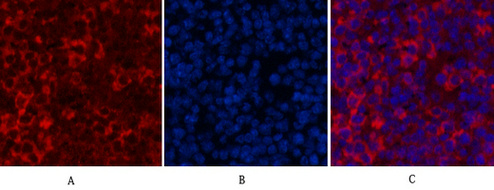
- Immunofluorescence analysis of Mouse-spleen tissue. 1,CYCS Monoclonal Antibody(4B10)(red) was diluted at 1:200(4°C,overnight). 2, Cy3 labled Secondary antibody was diluted at 1:300(room temperature, 50min).3, Picture B: DAPI(blue) 10min. Picture A:Target. Picture B: DAPI. Picture C: merge of A+B
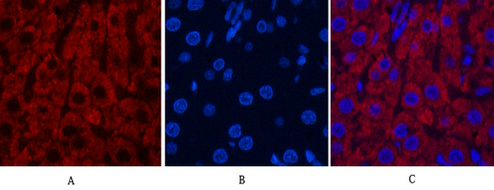
- Immunofluorescence analysis of Rat-liver tissue. 1,CYCS Monoclonal Antibody(4B10)(red) was diluted at 1:200(4°C,overnight). 2, Cy3 labled Secondary antibody was diluted at 1:300(room temperature, 50min).3, Picture B: DAPI(blue) 10min. Picture A:Target. Picture B: DAPI. Picture C: merge of A+B
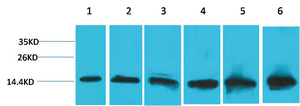
- Western blot analysis of 1) Hela, 2) 293T, 3) 3T3, 4) Mouse Liver Tissue, 5) Rat Liver Tissue, 6) Rat Kidney Tissue using CYCS Monoclonal Antibody.
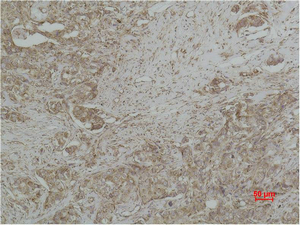
- Immunohistochemical analysis of paraffin-embedded human Breast caricnoma using CYCS Monoclonal Antibody.
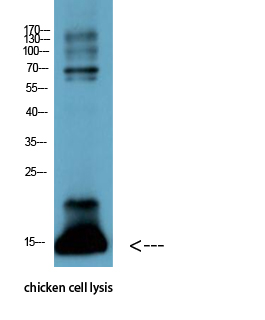
- Western Blot analysis of chicken cell lysis using Antibody diluted at 1:1000



